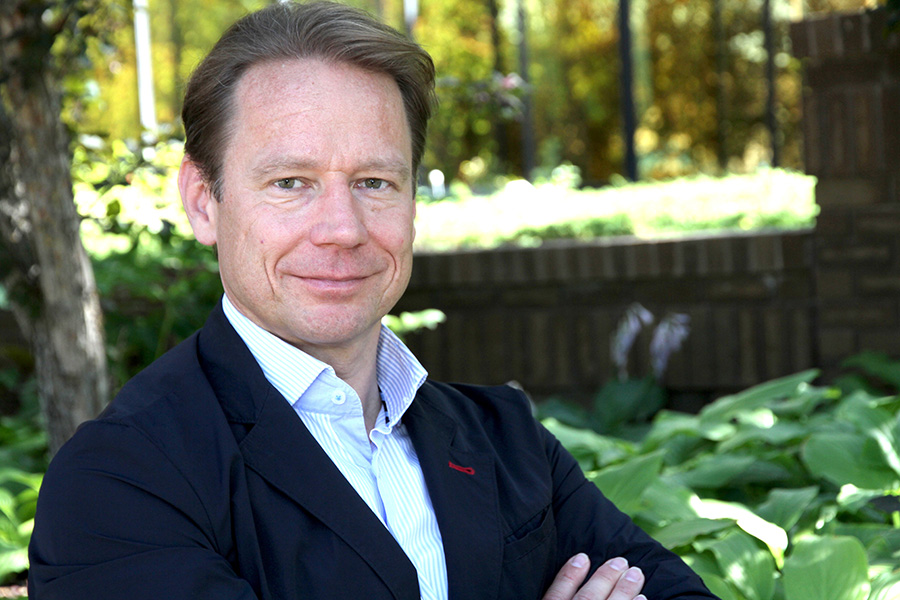
Innovation, wealth and the role of universities
As Johannes Dyring explained it, the wealth enjoyed in the modern world comes largely from the resources between our ears.
By Michael Robin"Eighty-five per cent of growth in GDP (gross domestic product) is due to innovation, new thinking," said Dyring, who took the helm as managing director of the university's Industry Liaison Office in October.
Yet, he explained the vast majority of the inventions coming out of universities are solutions in search of a problem—and that is a problem in itself.
"Most tech transfer offices in the world have technologies, and they need to bring them to market and try and develop products, which is very difficult and expensive," he said. "Tech-driven innovation means you have to find someone who needs it. I mean, where would you look? The world is huge."
Instead, Dyring advocates starting the research innovation process by identifying a need, whether it be found in industry, business or any other part of society.
"What I would like to do here is help the university to become yet more active and engaged and realize its role in the economic development of the country and society."
Dyring, whose academic training is in subatomic physics, was recruited from SLU Holding AB, where he served as CEO. A subsidiary of the Swedish University of Agricultural Sciences, the initiative provides venture capital and innovation support to researchers, employees and students. A successful entrepreneur, Dyring has launched ventures in the aerospace industry and business consulting. He also served as CEO of CONNECT Eastern Sweden, a privately funded non-profit business network that links entrepreneurs and young companies with growth potential to capital as well as practical business experience and resources.
Dyring said that a solution-driven approach need not and should not preclude curiosity-driven discovery research. Serendipity remains a rich and unpredictable source of innovation. Rather, he would like to see the invention ratio closer to 50-50—that is, half solutions to yet-to-be-discovered problems, and half solutions developed specifically for identified needs.
He also advocates building bridges among disparate and even unlikely areas of expertise which can also yield novel and unexpected ideas.
Dyring cites an example from the University of Maastricht in the Netherlands, where the chemistry department and law school came together to develop ideas. The result is a forensics company, the Maastricht Forensic Institute, which provides services to police, justice and advocacy groups, and the private sector.
While the word "invention" often evokes images of a new piece of software or high-tech engineering, creativity comes from all disciplines. And, inventions and innovations can come from just about anywhere, from just about anyone, faculty, administration, and, not the least, students.
"There's an interesting young company in Sweden using nature in treating people suffering from exhaustion syndrome and stress-related disorders," Dyring said. "They have developed a multidisciplinary method to treat and rehabilitate people."
The company uses horticulture, specifically gardens divided into different spaces. Each is designed to evoke a therapeutic response through shapes, textures of plants, colours of flowers and the like.
"They designed nature and treated and rehabilitated people—really, really sick people there—with great success. That's an innovation. Not high-tech, but lots of knowledge, know-how and psychology."
Dyring also names banker, economist and Nobel laureate Muhammad Yunus as an example of an innovator who has made an enormous difference in the world. Yunus founded Grameen Bank in Bangladesh, based on the pioneering concepts of microcredit and microfinance to give poor people the capital to lift themselves out of poverty through entrepreneurship.
This is the type of knowledge-driven benefit that universities can and should be delivering to the societies they serve, Dyring explained, arguing that over the centuries, their role and function has evolved.
At first, universities were devoted to education, passing on, for example, the wisdom of the classical Greek scholars. Later, they took on the role of knowledge creation through research. Today, the challenge is to spread this knowledge and help apply it.
"Now I believe we are in an age where universities have to have three fields of operation: education, research and impact," he said.
"Universities will become much more involved in economic development and improving welfare in countries than before, because they are true creators of new knowledge that's necessary for vital, sustainable development."
It will take a change in how universities see themselves and their role in society, a cultural shift that Dyring concedes will take time. In the meantime, the Industry Liaison Office will be working to help this process at the U of S.
"In addition to the exciting inventions and innovations that already come from the university, we can identify needs in society and industry," he said. "We can start an initiative, we can start a company, we can start an innovation process, because we know where to find the brightest brains in the university that could be part of developing a solution to a need or to a problem."

